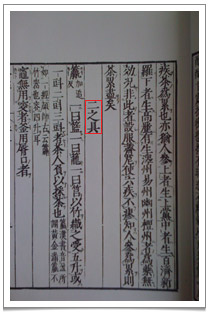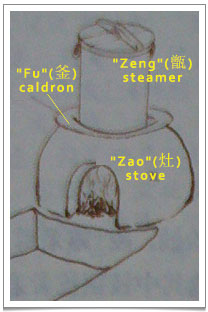Lu Yu: Classic of Tea Chapter 2 (Part I)

Tea saint Lu Yu’s Classic of Tea Chapter 2 in its original text. (To view the Chinese characters in this blog, you may need to enable character encoding of your web browser to either Unicode or Simplied Chinese.)
The second chapter of Lu Yu’s Classic of Tea (Cha Jing 茶经) documents the tea equipment in use in the 7th century A.D. – the 16 tools used in processing tea, from the picking stage, through the steaming, pressing and drying, to the storing and forming into cakes. They’re a bit more rudimentary but basically the same as the equipment still being used today.
Included in this chapter are references to ancient classical historical texts, units of measurement and the types of tea that were popular during the Tang dynasty. I have managed to find some pictures of this equipment from various Chinese tea books and have presented them here.
As I write this blog, the sounds and smells of my ancestors making tea with slightly primitive but ingenious tools seem to surround me. Reading Lu Yu is so evocative!
Table of Content
“Cha Jing” The Classic Treatise of Tea
by Lu Yu (760-780AD)
One: Origin 一之源:- This chapter expounds the mythological origins of tea in China. It also contains a horticultural description of the tea plant and its proper planting as well as some etymological speculation.
Two: Tools 二之具 (Part 1) & (Part 2):- This chapter describes 16 tools for picking, steaming, pressing, drying and storage of tea leaves and cake.
Three: Making 三之造:- This chapter details the recommended procedures for the production of tea cake.
Four: Utensils 四之器 (Part I), Part II & Part III:- This chapter describes twenty five items used in the brewing and drinking of tea.
Five: Boiling 五之煮:- This chapter enumerates the guidelines for the proper preparation of tea.
Six: Drinking 六之飲:- This chapter describes the various properties of tea, the history of tea drinking and the various types of tea known in 5th century China.
Seven: History 七之事:- This chapter gives various anecdotes about the history of tea in Chinese records, from Shennong through the Tang dynasty.
Eight: Growing Regions 八之出:- This chapter ranks the eight tea producing regions in China.
Nine: Simplify 九之略:- This chapter lists those procedures that may be omitted and under what circumstances.
Ten: Pictorial 十之圖:- This chapter consists of four silk scrolls that provide an abbreviated version of the previous nine chapters.
The first piece of equipment listed by Lu Yu is “ying” (籯): a simple bamboo basket for collecting freshly picked tea leaves. The ying had good ventilation which was important for keeping the tea leaves cool and slowing the oxidation process. Lu Yu talks about this basket as having a typical volume of 1, 2 or 3 “dou” (斗), a dou being both a type of scoop and a unit of measurement equivalent to about 2 litres. He refers to a saying from The Book of Han or “Han Shu” (汉书) (published 111 A.D., a history of the period 206 B.C. to 25 A.D.): “rather than leave a whole ying of gold to your children, leave a copy of a classical text!”
The second item listed by Lu Yu is the “zao” (灶), a stove for burning logs. He recommends using one without a smokestack.
The third item is the “fu” (釜) which is a kind of cauldron or kettle used in the steaming process. It might be made from iron, copper or clay. Lu Yu advises using one with a lip, probably to prevent any flint or smoke getting into the tea leaves from the log stove.
“Zeng” (甑) is the fourth item listed by Lu Yu. It resembled the typical bamboo steamer used in dim sum restaurants, but in ancient China it was made from wood or clay. Inside was a bamboo slat on which the tea leaves to be steamed would be laid. A little water would be added to the zeng, placed over the fu, to provide continuous steam. Then, Lu Yu says, the steamed leaves were spread out using a special three-pronged fork (made from branches from the tea fields), allowing them to cool and preventing their juices from escaping.
I believe this is one of the earliest records of the steaming of tea leaves to make green tea. Steaming was characteristic of the Tang Dynasty and was taken by Japanese monks back to Japan, where it remains the usual method of tea processing. The Chinese went on later to developing the techniques of pan-firing.
The fifth item, “wu jiu” (忤臼), also called “dui” (碓), is essentially a pestle used for crushing steamed tea leaves. Lu Yu says that the best wu jiu is one that has been frequently used. I imagined what Lu Yu meant was that a well seasoned pestle is easier to use than a brand new one.
The sixth item of equipment is a “gui” (规), also known as “mo” (模) or “juan” (桊). These are really little moulds in which steamed, softened tea leaves are pressed into cakes. The moulds, according to Lu Yu, were made from iron and could be round, square or fancy non-geometrical shapes. Again, this gives insight into the types of compressed tea commonly drunk during the Tang dynasty.
The seventh item is a “cheng” (承) which is a table used as a working surface for compressing teas. Often it was made from stone. Lu Yu says that, if on the other hand it’s made from the wood of the locust or mulberry tree, then the table’s legs should be half buried in the earth so as to provide a steady work surface.
Item number eight is a “chan” (檐 – a character which now refers to the eaves of a house). Lu Yu describes it as a used poncho or a piece of soft silk to be used as a tablecloth cover over the cheng. Gui would then be placed on top of the chan to make bricks of tea.
 Yin – A bamboo basket for holding tea leaf pickings. |
 Stove, cauldron and steamer for steaming of tea leaves. |
|
 A stone work surface covered with a silk cloth for compressing tea leaves into tea cakes using moulds. |
The 9th to the 16th pieces of apparatus will be detailed in the Part 2 of Cha Jing Chapter 2 in the next blog.
|
Warmly, Pei ~~ Serene and fragrant TEA entices with promise of rapture in STORE ~~ |

